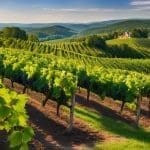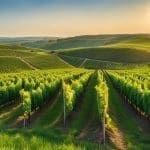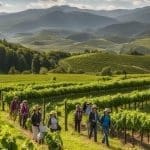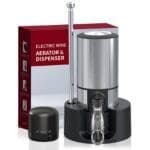When I think about Mendoza wine, the first image that pops into my head is of expansive vineyards, nestled snugly at the foot of the Andes, basking in golden sunlight. This Argentine region is a wine lover’s dream, a place where the Malbec grape has found its truest expression. You can’t discuss Argentina wine without homage to the lush, rolling landscapes of Mendoza, and my wine exploration through this storied province has been nothing short of enchanting.
Among the rows of vines that stretch towards the horizon, the air is alive with the spirit of passion and precision that goes into nurturing the finest wines. From the illustrious heights of the vineyards, I’ve witnessed firsthand why Mendoza’s Malbec has captured the hearts of connoisseurs globally. The elevation here is more than a mere geographical statistic; it’s a crucial ingredient in the alchemy that turns simple grapes into bottles of sensory delight.
As an epicurean at heart, my pursuit of remarkable wines has led me through various landscapes, but Mendoza stands out with an allure that is tangible. It’s not just the wine itself; it’s the symphony of nature and human skill that creates it. This haven is a testament to the fervour with which Argentina has embraced viticulture and perfected it to an art form.
Key Takeaways
- Mendoza, the heartland of Argentina’s wine production, yields an impressive two-thirds of the nation’s wines with Malbec taking centre stage.
- The unique high-altitude vineyards contribute to the wines’ distinctive aromas and depth of flavour.
- Historical European influence and innovative winegrowing practices have shaped Mendoza’s world-renowned wine profile.
- Exploring Mendoza’s wine region offers not just a taste but a vivid journey through its vibrant wine-making culture and stunning scenery.
- A commitment to quality and diversity signals Mendoza’s position as a premier destination in the global wine community.
Discovering Mendoza: The Heart of Argentina’s Winemaking
Mendoza, with its rich viticultural tapestry, is worthy of exploration, not just for its sensational landscapes, or the pure Andean air, but for its viticulture – a craft that has been perfected over centuries. Beneath the Andean sun, each vineyard tells a story, a tale of tradition, struggle, and triumph. Let’s delve into the multifaceted world of Mendoza wines, where history and high altitudes fuse into every bottle.
The Dawn of Wine: History and Development in Mendoza
The confluence of Incan agricultural wisdom and Jesuit vigour in the 16th century marked the embryonic phase of Mendoza wine history. I find the vivid narrative enthralling: how the sweeping railroad and European migrants escaping the phylloxera crisis catalysed the foundations of the modern Argentina wine industry. It is this era that brought the rich European influence on viticulture, embedding in Mendoza the varietals that would command its wine identity, including the celebrated Malbec.
Breathtaking Altitudes: How Elevation Shapes Mendoza’s Vineyards
As I walk through these high altitude vineyards, it’s easy to sense how the majestic Andes impact on viticulture, gifting these lands with ideal winegrowing conditions. The vines here, rising up to 1,200 metres, are draped in sunlight, nurturing grapes with robust flavours and an intensity that is nearly poetic. Indeed, the grape ripening is an orchestration of nature’s elements – a testament to the serendipity of elevation and environmental symbiosis in winemaking.
A Varied Palette: Exploring the Diversity of Mendoza’s Grape Varieties
One cannot discuss the vigour of Mendoza’s vineyards without praising the spectrum of grape varieties that dot its landscapes. From the indigenous Criolla Grande and Cereza grape varieties to the array of premium wine varietals, the region’s vinous mosaic is rich and complex. Malbec’s prominence among Mendoza’s offerings is underscored by its unrivalled quality, which I believe sings of the earth it sprouts from. Each varietal, whether the sturdy Cabernet Sauvignon or the ethereal Chardonnay, contributes a unique brushstroke to Mendoza’s broad viticultural canvas.
In my journey through the heart of Mendoza, I’ve encountered stories set against the backdrop of the Andes, watched over by snow-capped guardians. Here, the winemaking legacy is as profound as the mountains themselves, a symbol of Argentina’s unyielding commitment to cultivating the nectar of the gods.
Mendoza Wine: A Journey through Flavours and Aromas
As we delve into the heart of Argentinian winemaking, it’s impossible not to marvel at the incredible journey of Mendoza’s fine wines, especially the globally celebrated Malbec. So grab a glass and let me guide you through the tantalising world of Mendoza’s full-bodied reds.
Malbec: The Crown Jewel of Mendoza Wineries
I’ve swirled, sniffed, and sipped my way across countless vineyards, and nothing compares to the top-rated Malbec stemming from the rolling vineyards of Luján de Cuyo and the Uco Valley. The high altitude gifts these wines with a robust complexity that’s hard to find elsewhere. I can easily see why the Argentinians beam with pride over their Malbec—it truly is a sumptuous feast for the senses.
High-Altitude Harvest: The Unique Viticulture of the Andes
It’s not just about the grape varietals; it’s where they’re grown. The Andean viticulture, with vineyards perched like natural skyscrapers, allows grapes to mature in ways they just can’t at sea level. Let’s not overlook the skilled use of irrigated vineyards here, which date back to ancient times yet remain crucial for the thriving vines amidst these mountain giants.
From Barrel to Bottle: Winemaking Techniques in Mendoza
There’s an intricate ballet performed by the winemakers in Mendoza, starting at the vine and ending when the cork seals the bottle. Each step is carefully choreographed, combining time-honoured oenological practices with cutting-edge technology. At wineries like Bodega Catena Zapata, they’re even exploring how sunlight intensity shapes a grape’s sagacity—it’s absolutely fascinating.
Finally, I can’t recommend enough embarking on Mendoza winery tours. To experience the passion behind each bottle and comprehend the journey from barrel to bottle is a must-do for any wine aficionado. It’s a story best savoured one sip at a time, encased in the breathtaking scenery of the rugged Andes. ‘Til next time, cheers!
Conclusion
The Mendoza region’s allure for me is evident through its harmonious blend of terroir diversity, history, and high-elevation vineyards which together forge an enchanting narrative for any wine enthusiast. As a tried-and-true destination for Mendoza wine tourism, I’ve observed the region stand tall, not merely on its altitude but on the heightened experiences it offers. The spirit of Argentinian wine culture flows as freely as the wine itself, inviting me and others to delve into its rich tapestry with each visit.
The wines, so intimately connected with the people and the land, continue to tell a story of tradition and innovation intertwined. Every glass I’ve tasted from Mendoza has been a testament to the complexity and enchantment that the land imprints upon its produce. The region has asserted itself as a paramount wine lovers’ destination, not just in Argentina, but across the globe.
As someone passionate about wine and the tales it tells, my explorations of Mendoza have been unforgettable journeys, offering far more than the sum of its parts. I am consistently impressed by the heartfelt dedication behind each bottle, and it’s this dedication that beckons connoisseurs and casual sippers alike to immerse themselves in the vibrant essence of Mendoza’s winemaking legacy.
FAQ
What makes Mendoza wine so unique?
Mendoza wine owes its uniqueness to a combination of factors; the high-altitude vineyards provide ideal growing conditions, with the Andes greatly influencing the climate and sunlight intensity. This, alongside the rich history that includes European influence on viticulture and a diverse array of grape varieties, including the prominent Malbec, contribute to the distinct and enchanting character of Mendoza wines.
How did Mendoza become Argentina’s wine capital?
Mendoza’s ascent as the wine capital of Argentina is deeply rooted in its history. Starting with the Jesuit priests in the 16th century and spurred by European immigration and the railroad’s completion in the 19th century, the region’s viticulture flourished. These historical developments, combined with its ideal winegrowing conditions, propelled Mendoza to the forefront of the Argentina wine industry.
Why is Malbec so significant in Mendoza?
Malbec is significant in Mendoza because it has found a perfect match in the region’s high altitude and sunny conditions, allowing it to develop a rich and full-bodied profile that has gained international acclaim. It has become synonymous with Argentinian wine identity, prominently featuring in Mendoza wine explorations and cementing the region’s place on the global wine map.
Can you tell me more about the history and development of wine in Mendoza?
The winemaking tradition in Mendoza began with early vine plantings by Jesuit priests. Development was accelerated in the 19th century, particularly following the arrival of European immigrants who expanded the industry as they sought refuge from phylloxera in their homelands. Mendoza’s wine history intertwines with Argentina’s national narrative, thriving through centuries of cultivation and innovation.
What role does the elevation of Mendoza’s vineyards play in its winemaking?
Elevation is crucial in shaping Mendoza’s vineyards. The increased altitude leads to more intense sunlight and cooler temperatures, contributing to the development of grapes with robust flavours and ideal acidity. This elevated viticulture results in wines that possess a unique balance and complexity that are characteristic of high-altitude regions like Mendoza.
What grape varieties can be found in Mendoza’s vineyards aside from Malbec?
Beyond Malbec, Mendoza’s vine-coloured palette includes an array of grape varieties such as Cabernet Sauvignon, which contributes to the region’s complex red wines, and Chardonnay, bringing elegance to the white wine roster. Other varieties like Criolla Grande, Cereza, and Tempranillo play essential roles in enhancing Mendoza’s diversity in wine varietals.
What makes Mendoza’s viticulture unique?
Mendoza’s viticulture is distinguished by its reliance on high-altitude terrain and a continental climate benefited by Andean winds. Its ancient irrigation systems, modern water management, and dynamic response to challenges such as La Piedra hailstorms, contribute to sustainable practices that yield exceptional flavour in its wines.
How have winemaking techniques evolved in Mendoza?
Winemaking techniques in Mendoza range from ancestral methods to modern technological advances. The region’s winemakers continuously experiment with practices like selective harvesting and micro-vinification to refine the quality of their wine. Wineries engage in research to optimize conditions, from sunlight intensity to soil management, ensuring Mendoza’s wines thrive at their peak potential.
Are there tours available for wine enthusiasts wanting to explore Mendoza’s wineries?
Absolutely, there are numerous tours available that cater to wine enthusiasts looking to delve into the heart of Mendoza’s winemaking tradition. These tours typically offer visits to various wineries, tasting sessions of Mendoza’s fine wines, and opportunities to learn about the winemaking process from vine to bottle, all set against the stunning backdrop of the Andes.
Why is Mendoza considered a top destination for wine lovers?
Mendoza is a haven for wine lovers due to its enchanting blend of rich winemaking history, dynamic range of flavorful wines, and breathtaking landscapes. The combination of high-elevation vineyards, the culture woven into each bottle, and innovative winemaking makes Mendoza an irresistible destination for those looking to merge their passion for wine with a deep cultural experience.
Source Links
- https://en.wikipedia.org/wiki/Mendoza_wine
- https://www.winetourism.com/wine-region/mendoza/
- https://www.wine-searcher.com/regions-mendoza
Sip smarter, subscribe now!
Subscribe for gourmet tips, event updates, travel ideas, and a free e-book on Food Pairings. Start your journey to culinary and travel excellence!















